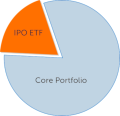J&J spin-off Kenvue (KVUE) dominated headlines last week, raising $3.8 billion in the largest US IPO since 2021, and the sixth-largest deal of the past 10 years. In many ways, Kenvue stands alone among the largest IPOs of the past decade: A mature, profitable business going public in a challenging environment provides stark contrast to the fast-growing, highly-unprofitable issuers that dominated prior years' bull market. Still, the company jumped 22% on its first day, well above the 10-year median for billion-dollar IPOs (12%), and in line with the average (+21%). The billion-dollar IPOs from 2013-2016 have performed better than their newer counterparts, thanks to having fewer tech names and a longer trading period.
For access to more exclusive content like this, as well as in-depth data, advanced screening capabilities, and more, sign up for a free trial of IPO Pro, the platform that gives you all of the IPO and SPAC information you need, all in one place.
The 10 largest issuers of the past decade by deal size average a whopping 48% first-day pop, driven by explosive initial trading from the late-2020 tech IPOs (ABNB, DASH, SNOW). Most went public during the 2020-2021 IPO boom, and 8 of the 10 came from the tech sector; aside from Kenvue, EV maker Rivian was the only non-tech deal, though it also had the lowest revenue of the group. Additionally, aside from Kenvue, only Alibaba was profitable at IPO. This largest group has largely traded off in the aftermarket, averaging a -15% return from offer (vs. 1% for the broader billion-dollar group), with the largest losses from Rivian and Chinese ridesharing giant DiDi. Only four of the 10 largest currently trade above issue.



